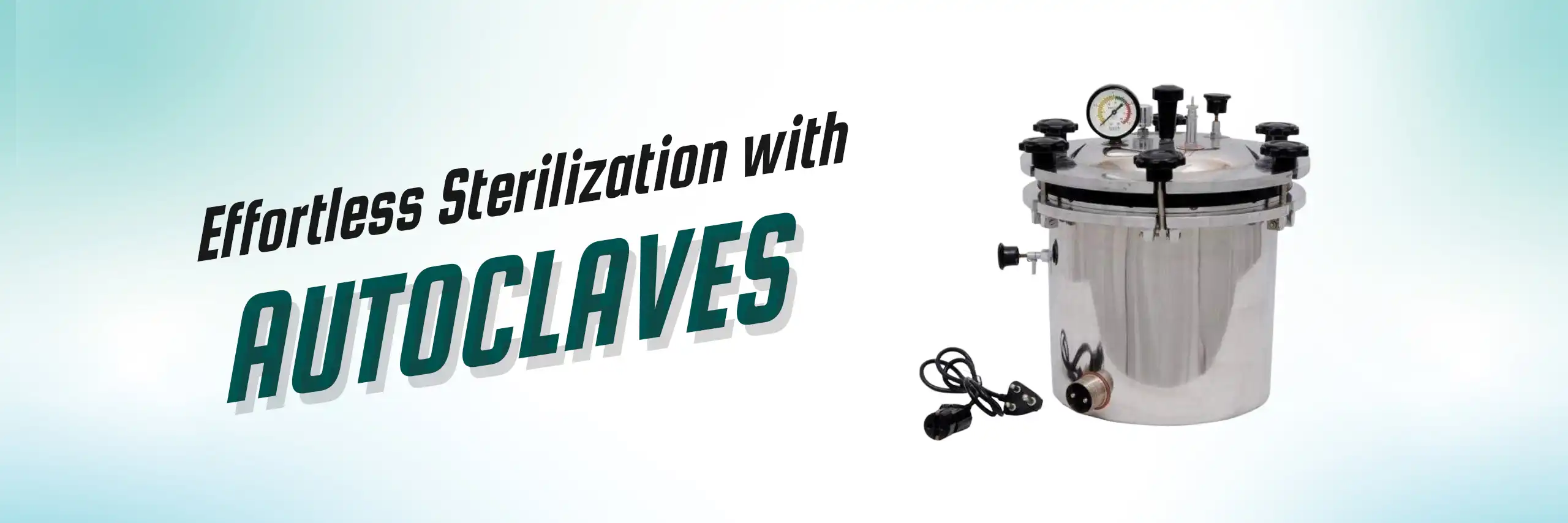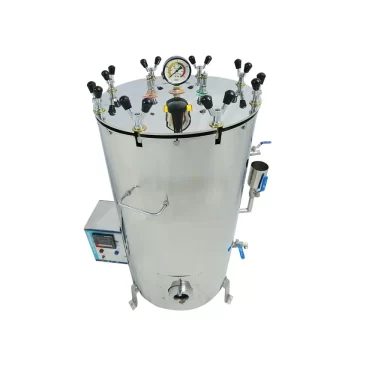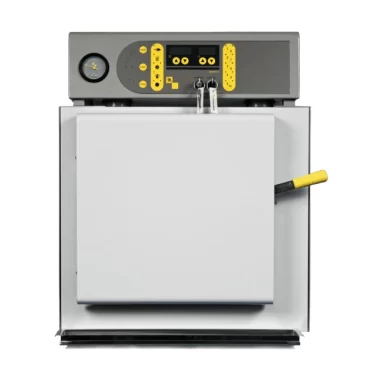- Your cart is empty
- Continue Shopping
Exploring Autoclaves: From Cooker-Type Models to Advanced Sterilizers

Autoclaves play an important role in maintaining hygiene and sterility in medical, laboratory, and industrial settings. Using pressurized steam, these devices effectively eliminate harmful microorganisms. However, the variety of autoclaves available today caters to diverse needs, making it essential to understand their types before selecting the right one made to your needs and wants.
In this blog, we’ll dive into the different types of autoclaves, including the commonly used cooker-type autoclaves, knob-type models, and other advanced sterilization solutions available in the market.
What Makes Autoclaves a Sterilization Essential?
Autoclaves play an important and unavoidable role as an indispensable tool for getting rid of bacteria, viruses, fungi, and spores from equipment and materials. They use a combination of high heat and pressure to make sure of sterilization. These devices are critical in fields where maintaining a sterile environment is paramount, including healthcare, research, and food production.
The benefits of autoclaves include:
- Infection Prevention: They protect against contamination in surgical and medical environments.
- Research Accuracy: Sterile tools eliminate variables in scientific studies.
- Industrial Compliance: Industries depend on autoclaves for hygiene in manufacturing processes.
If you’re looking to purchase high-quality autoclaves, reliable autoclave dealers in Kottayam such as Life Care Cart can offer a wide range of models suited for various applications, from basic setups to sophisticated sterilization systems.
From Simple to Sophisticated: Types of Autoclaves
Autoclaves come in various designs and functionalities. Each type serves specific sterilization needs, ranging from basic setups to highly advanced systems. Below, we will look at these types and their applications more closely.
Cooker-Type Autoclaves: A Budget-Friendly Sterilization Solution
Cooker-type autoclaves look like pressure cookers in design at first sight and are among the simplest forms of autoclaves.
Key Features:
- Operated manually with basic controls.
- Equipped with a pressure gauge and release valve.
Where They’re Used:
- Small clinics and rural healthcare setups for sterilizing basic instruments.
- Educational institutions for teaching and training purposes.
Why Choose Them:
- Affordable and easy to operate.
- Require minimal training and maintenance.
Knob-Type Autoclaves: Combining Simplicity with Control
Knob-type autoclaves offer more functionality than cooker-type models, making them suitable for slightly advanced sterilization needs.
Key Features:
- Manual control knobs for adjusting pressure and temperature.
- More versatile than basic cooker-type models.
Where They’re Used:
- Small medical facilities and veterinary practices.
- Labs that require basic sterilization capabilities.
Why Choose Them:
- Cost-effective and user-friendly.
- Ideal for users needing more control over sterilization parameters.
Benchtop Autoclaves: Compact Sterilizers for Daily Use
Benchtop autoclaves are small and portable, perfect for settings where space is minimal.
Key Features:
- Available in both gravity displacement and pre-vacuum options.
- Compact design ideal for countertop placement.
Where They’re Used:
- Dental clinics for sterilizing small instruments.
- Tattoo studios, beauty salons, and research labs.
Why Choose Them:
- Space-saving design and portability.
- Suitable for sterilizing smaller loads.
Horizontal Autoclaves: Bulk Sterilization Champions
Horizontal autoclaves are designed for large-scale operations, making them a staple in hospitals and industrial facilities.
Key Features:
- Large chambers capable of sterilizing bulk loads.
- Advanced control systems for precise sterilization.
Where They’re Used:
- Hospitals for sterilizing surgical tools, linens, and utensils.
- Pharmaceutical industries for mass sterilization.
Why Choose Them:
- High capacity and efficiency.
- Suitable for diverse sterilization needs.
Vertical Autoclaves: Space-Saving Sterilization Power
Vertical autoclaves are an alternative to horizontal models, designed to save space without compromising functionality.
Key Features:
- Cylindrical chambers with a top-loading design.
- Ideal for medium-scale sterilization.
Where They’re Used:
- Research labs for sterilizing glassware and liquids.
- Clinics and small hospitals with limited space.
Why Choose Them:
- Efficient use of vertical space.
- Affordable compared to horizontal models.
Portable Autoclaves: Sterilization On the Go
Portable autoclaves are designed for mobility, making them ideal for remote or fieldwork situations.
Key Features:
- Lightweight and easy to transport.
- Can be powered by electricity or gas.
Where They’re Used:
- Field clinics and mobile veterinary units.
- Emergency response setups and on-site laboratories.
Why Choose Them:
- Easy to carry and set up.
- Practical for sterilizing basic tools on the move.
Pre-Vacuum Autoclaves: For Advanced Sterilization Needs
Also known as vacuum-assisted autoclaves, these devices are highly efficient at removing air from the chamber, making sure of thorough sterilization.
Key Features:
- Advanced systems made for air removal and steam penetration.
- Suitable for porous and complex materials.
Where They’re Used:
- Medical facilities for sterilizing tools with lumens or intricate designs.
- Industries that require high standards of sterilization.
Why Choose Them:
- Effective for complex and porous loads.
- Guarantees uniform sterilization.
Laboratory Autoclaves: Customised for Precision
Laboratory autoclaves are designed to meet the sterilization needs of research and pharmaceutical labs.
Key Features:
- Precise temperature and pressure controls.
- Capable of sterilizing sensitive materials like culture media.
Where They’re Used:
- Research labs for sterilizing liquids, samples, and tools.
- Pharmaceutical facilities for production processes.
Why Choose Them:
- Highly accurate and reliable for sensitive applications.
- Versatile for sterilizing a wide range of materials.
How to Choose the Right Autoclave for Your Needs
When you are planning to choose an autoclave, think about the following things:
- Capacity Requirements: Determine the volume of sterilization needed.
- Application: Match the autoclave type to your specific sterilization tasks.
- Budget: Evaluate initial cost, maintenance expenses, and accessory needs.
- Automation: Decide between manual options like knob-type or automatic pre-vacuum models.
Whether you’re buying for a hospital, clinic, or laboratory, buying from trusted autoclave dealers in Kottayam such as Life Care Cart can guide you in choosing the perfect model that aligns with your requirements.
Maintaining Your Autoclave: Best Practices
Regular and proper service is important for making sure of the longevity and performance of your autoclave. Follow these tips:
- Clean Regularly: Prevent buildup in the chamber and valves.
- Calibrate Periodically: Make sure of accurate temperature and pressure readings.
- Service Checks: Schedule professional inspections to avoid costly breakdowns.
By understanding the features and applications of different autoclaves, from basic cooker-type and knob-type models to advanced vacuum-assisted and laboratory units, you can make an informed choice based on your sterilization needs.





